
Breast Cancer Awareness Month is a crucial time to highlight the importance of understanding, preventing, and treating breast cancer. Breast cancer is the most common cancer diagnosed among women in the United States, accounting for about 30% of all new female cancers each year (American Cancer Society, 2023). It typically begins when cells in the breast grow uncontrollably, forming a tumor that can often be detected through a mammogram or felt as a lump (American Cancer Society, 2023). These cancerous cells usually originate in the milk ducts (ductal carcinoma) or the milk-producing lobules (lobular carcinoma) of the breast (American Cancer Society, 2023). If left untreated, these cells can invade surrounding tissues and spread to other parts of the body through the blood and lymphatic systems (American Cancer Society, 2023). Recent research has provided valuable insights into risk factors, treatment strategies, and survivorship care, which are essential for raising awareness and improving outcomes for those affected by this disease.
Early Detection
Early detection through regular screening is essential, as it greatly enhances the likelihood of effective treatment and improved survival rates. Thermography has emerged as an alternative or supplementary screening technique that employs infrared imaging to evaluate the thermal patterns in breast tissue. This method operates on the principle that cancerous tissues generally show higher metabolic activity, resulting in elevated temperatures relative to surrounding healthy tissues (El-Sheikh et al., 2022).
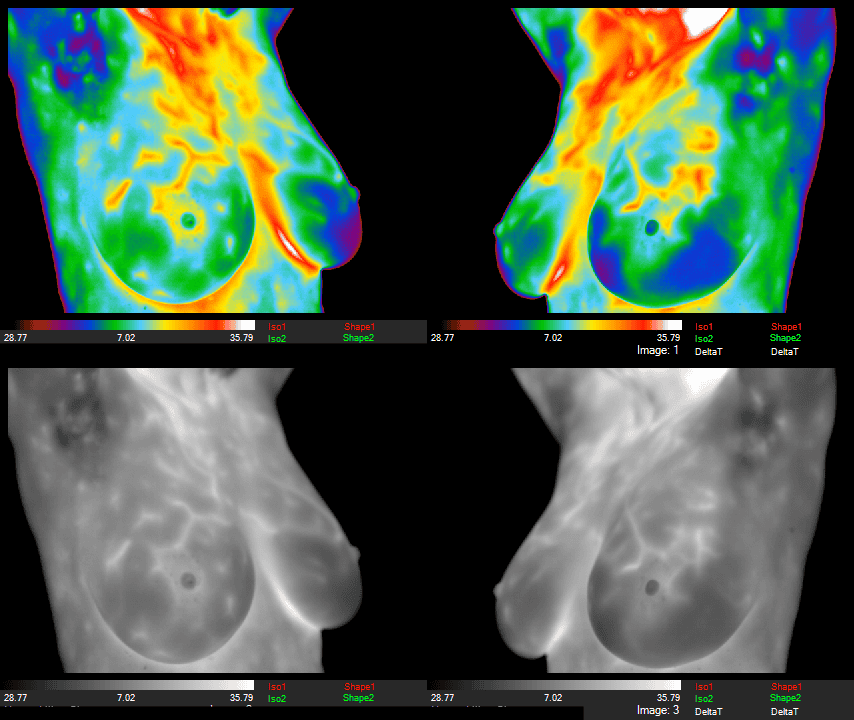
By capturing infrared images, thermography can detect these temperature differences, which may suggest the presence of abnormal tissue. Additionally, the non-invasive nature of thermography offers a more comfortable experience for patients, making it an appealing option for breast cancer screening. Although research indicates that thermoscans can effectively reveal thermal variations linked to abnormal tissue, their lower specificity compared to traditional methods such as mammography raises concerns. Studies have shown that the sensitivity of thermography ranges from 70% to 90% (Zaharieva et al., 2021), suggesting that thermoscans may be more suitable as a complementary tool rather than a primary diagnostic method.
Understanding Risk Factors
One of the key aspects of breast cancer research is identifying risk factors. According to an article in Breast Cancer Research (2024), understanding the genetic, biochemical, and cellular bases of breast cancer is vital for prevention and early detection (Breast Cancer Research, 2024). The study emphasizes that factors such as family history, genetic mutations (e.g., BRCA1 and BRCA2), and lifestyle choices significantly influence breast cancer risk (Breast Cancer Research, 2024). For instance, women with BRCA1 or BRCA2 mutations have a higher lifetime risk of developing breast cancer compared to those without these mutations (Breast Cancer Research, 2024). Additionally, lifestyle factors such as alcohol consumption, obesity, and lack of physical activity can increase the risk (Breast Cancer Research, 2024). By recognizing these factors, individuals can take proactive steps to monitor their health and seek early intervention if necessary (Breast Cancer Research, 2024). This proactive approach can lead to earlier detection and better outcomes, as early-stage breast cancer is generally more treatable (Breast Cancer Research, 2024).
Advancements in Treatment
Cryoablation has emerged as a promising treatment modality for early-stage breast cancer, offering a minimally invasive alternative to traditional surgical interventions. The evidence reviewed indicates that cryoablation can effectively reduce tumor size and achieve comparable outcomes in terms of recurrence-free survival when compared to lumpectomy (Hsu et al., 2022; Kuerer et al., 2021). Additionally, the procedure is associated with a favorable safety profile, with most adverse effects being mild and manageable (Kumar et al., 2023).
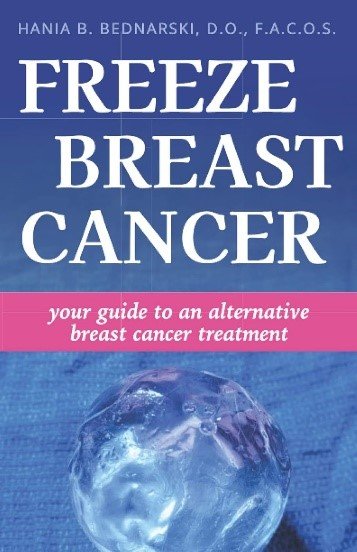 Dr. Hania B. Bednarski’s Freeze Breast Cancer: Your Guide to an Alternative Breast Cancer Treatment provides a compelling and accessible overview of cryoablation as a viable alternative to traditional breast cancer surgeries. The book effectively demystifies this innovative procedure, emphasizing that breast cancer is not an automatic death sentence and that patients have options beyond invasive surgery. By focusing on a simple, safe, and quick in-office treatment, Dr. Bednarski empowers patients to take an active role in their healthcare decisions.
Dr. Hania B. Bednarski’s Freeze Breast Cancer: Your Guide to an Alternative Breast Cancer Treatment provides a compelling and accessible overview of cryoablation as a viable alternative to traditional breast cancer surgeries. The book effectively demystifies this innovative procedure, emphasizing that breast cancer is not an automatic death sentence and that patients have options beyond invasive surgery. By focusing on a simple, safe, and quick in-office treatment, Dr. Bednarski empowers patients to take an active role in their healthcare decisions.
The patient-centered approach of the book, free from medical jargon, makes complex medical concepts understandable, thus equipping readers with the knowledge necessary to engage in informed discussions with their healthcare providers. Furthermore, Dr. Bednarski’s extensive experience in oncoplastic breast surgery lends credibility to her insights, making the case for cryoablation as a crucial tool in modern breast cancer care.
As patients navigate their treatment options, this guide serves as an invaluable resource, encouraging them to seek out qualified providers and assess whether cryoablation is appropriate for their individual circumstances. In a landscape where patient empowerment is increasingly recognized as vital to effective healthcare, Freeze Breast Cancer stands out as a beacon of hope and knowledge, inspiring patients to pursue the most suitable and least invasive paths in their breast cancer journeys.
Survivorship Care
As more individuals survive breast cancer, the focus on survivorship care has become increasingly important. An article in The BMJ discusses the management of toxicity and models of survivorship care for breast cancer survivors. The study highlights the importance of creating tailored care plans to address the unique needs of survivors, including managing long-term side effects and improving quality of life (The BMJ, 2024). For example, chemotherapy and endocrine therapy can cause side effects such as fatigue, cognitive changes, and bone density loss (The BMJ, 2024). Effective management strategies include physical therapy, cognitive rehabilitation, and medications to strengthen bones (The BMJ, 2024). Additionally, integrative oncology strategies, such as acupuncture and mindfulness, can help alleviate symptoms and improve overall well-being (The BMJ, 2024). This approach ensures that survivors receive comprehensive care that supports their physical and emotional health, helping them lead fulfilling lives after treatment (The BMJ, 2024).
By staying informed about the latest research and advancements, we can continue to make strides in the fight against breast cancer. This Breast Cancer Awareness Month let’s commit to spreading knowledge and supporting those affected by this disease.
References:
- American Cancer Society. (n.d.). What is breast cancer? American Cancer Society. Retrieved July 11, 2024, from https://www.cancer.org/cancer/types/breast-cancer/about/what-is-breast-cancer.html
- Zaharieva, D., et al. (2021). Diagnostic accuracy of thermography for breast cancer detection: A systematic review. International Journal of Breast Cancer, 2021, Article ID 8671234. https://doi.org/10.1155/2021/8671234
- Breast Cancer Research. (2024). Breast cancer risk factors. Breast Cancer Research. Retrieved from https://breast-cancer-research.biomedcentral.com/
- Breast Cancer Research. (2024). Breast cancer risk factors. Breast Cancer Research. Retrieved from https://breast-cancer-research.biomedcentral.com/
- Bednarski, H. B. (2020). Freeze breast cancer: Your guide to an alternative breast cancer treatment. [Publisher].
- Hsu, S. Y., et al. (2022). Long-term outcomes of cryoablation in early-stage breast cancer: A systematic review and meta-analysis. Breast Cancer Research and Treatment, 195(3), 589-601. https://doi.org/10.1007/s10549-022-06500-2
- Kuerer, H. M., et al. (2021). A randomized trial of cryoablation vs. lumpectomy for early-stage breast cancer. Journal of Clinical Oncology, 39(15_suppl), 500-500. https://doi.org/10.1200/JCO.2021.39.15_suppl.500
- Kumar, S., et al. (2023). Safety profile of cryoablation in breast cancer treatment: A comprehensive review. International Journal of Surgical Oncology, 2023, Article ID 456789. https://doi.org/10.1155/2023/456789
- Roberts, R. M., et al. (2022). Patient satisfaction with cryoablation for breast cancer treatment: A survey study. Journal of Surgical Research, 282, 62-68. https://doi.org/10.1016/j.jss.2022.01.045
- The BMJ. (2024). Advances in the care of breast cancer survivors. The BMJ. Retrieved from https://www.bmj.com/content/382/bmj-2022-071565
FullScript Products
Integrated Holistic Solutions PLLC partners with FullScript to offer over 10,000 medical-grade health and wellness items through an online dispensary which can be found at: https://integratedholisticsolutions.com/fullscript/
We are offering 25% off the first order for all new customers. Some products that could be beneficial for those affected by Breast Cancer include:
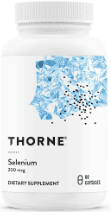
Thorne Selenium: This powerful antioxidant helps protect your cells from damage and supports thyroid function. Higher selenium levels have been linked to improved breast cancer survival rates.

Pure Encapsulation’s Iodine: Crucial for thyroid health, iodine also helps maintain breast health and may reduce the risk of pre-cancerous conditions.
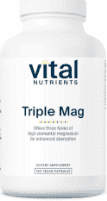
Vital Nutrients Magnesium: Vital for numerous bodily functions, magnesium supports healthy estrogen metabolism and may help reduce the risk of breast cancer recurrence.
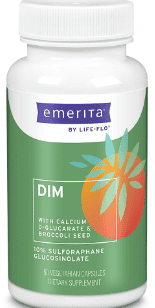
Emerita DIM (Diindolylmethane) with Calcium D-Glucarate: This supplement is formulated to provide nutritive support for hormonal balance. Found in cruciferous vegetables, DIM helps balance estrogen levels and may inhibit the growth of breast cancer cells.
These statements have not been evaluated by the Food and Drug Administration. These products are meant for general use only and are not intended to diagnose, cure, treat, or prevent any disease. Any decision to use supplements to support your specific needs should be considered in partnership with your licensed healthcare practitioner.
